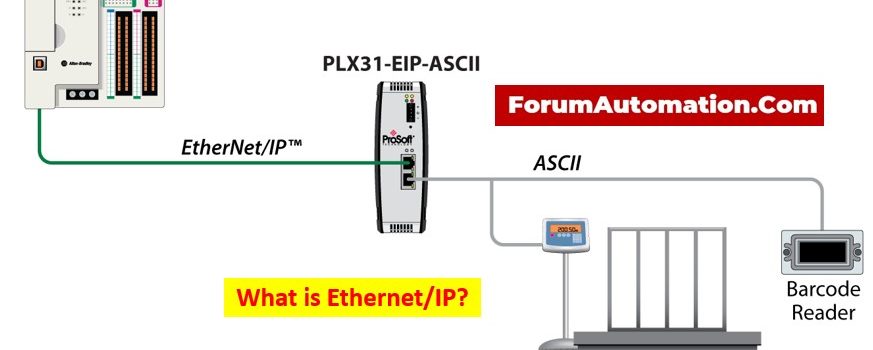
- EtherNet/IP is developed by rockwell automation in the 90s
- Common industrial protocols (CIP) over TCP/IP.
- Independently supported/promoted by OVDA
- Open standard,open source OpEner software.
- Transfer IO data through UDP.It is fast but delivery is not assured.(Implicit messaging)
- File transfer via TCP.It is slow but delivery is assured.File transfer means uploading and downloading of parameters,setpoint, programs and recipes via TCP.
-
What is EtherNet/IP?
EtherNet/IP (or) Ethernet/IP protocol is a popular industrial communication protocol that enables real-time control and data transmission between devices in the industrial automation systems.
- It is an implementation of the Common Industrial Protocol (CIP) over conventional Ethernet infrastructure that enables the smooth integration of devices from several manufacturers.
EtherNet/IP supports both peer-to-peer and client-server communication formats and is well-known for its flexibility, scalability, & interoperability, making it an ideal option for industrial applications like manufacturing, process control, and robotics.
How Does EtherNet/IP Work?
EtherNet/IP is operated on the client-server concept and employs ordinary Ethernet connectivity to exchange data between equipment in an industrial automation system. This is how EtherNet/IP works:
Physical Layer
EtherNet/IP provides physical connectivity with ordinary Ethernet gear and cabling. Ethernet cables and switches connect devices to the network, including PLCs, I/O modules, drives, sensors, & HMIs.
TCP/IP Protocol Stack
EtherNet/IP runs at the TCP/IP protocol stack’s application layer, which also comprises Ethernet framing, IP addressing, & TCP/UDP transport levels.
Common Industrial Protocol (CIP)
EtherNet/IP exchanges data and communicates with devices via the Common Industrial Protocol (CIP), an object-oriented protocol suite. CIP defines a set of services & objects that allow devices to communicate with one another. These solutions include explicit and implicit messaging, as well as device discovery.
Connection Establishment
Devices communicate via the client-server mechanism. A client device initiates communication by sending a request to the server. The server device replies to the client’s request by providing the requested data (or) performing the requested action.
Message Types
Explicit Messaging: The client delivers explicit requests to specified server devices utilizing CIP services. This approach is often employed for point-to-point communication among devices.
Implicit Messaging: Data is transmitted between devices without explicit demands. Devices send data to the network, & other devices subscribe to the information they require. This approach is frequently employed for real-time data sharing among numerous devices.
Data Representation
Data transmitted between devices is expressed utilizing CIP objects, which define the data’s structure and format. CIP objects can include a variety of data types, including integers, floating-point numbers, texts, and custom data structures.
Device Profiles
EtherNet/IP defines device profiles, which describe the communication capabilities & requirements of many types of devices. Device profiles define standardized communication interfaces, ensuring interoperability between devices from various manufacturers.
Advantages of EtherNet/IP
Compatibility
EtherNet/IP is interoperable with standard protocols & transport devices that use classic Ethernet, making it simple to implement.
Standard
Ethernet has become a widely recognized certifiable standard, to the point where equipment must be verified by EtherNet/IP test labs according to QoS.
Universal Use
EtherNet/IP has been utilized in almost every business; hence its universality has made it a popular protocol.
Why use Ethernet IP?
EtherNet/IP provides the speed, precision, and dependability required to manage & control information in real time by linking devices to a single network, enabling users to collect relevant data that helps keep essential systems running.
What is Ethernet TCP IP?
Ethernet TCP/IP is a typical Ethernet interface that connects several network nodes, which include computers in an office network. It can also be utilized for connecting other communication equipment, such as scanners & PLCs, on a factory floor.
Difference Between Ethernet and EtherNet/IP
Ethernet vs EtherNet/IP
Ethernet EtherNet/IP Ethernet is a popular networking technology that specifies the physical & data link layers of the OSI model. EtherNet/IP runs at the application layer of the OSI model, with TCP/IP serving as its underlying transport protocol. Ethernet requirements include frame formats, media access control (MAC) addresses, collision detection, & data transmission rates. It specifies a number of services and objects for device communication, such as explicit messaging, implicit messaging, device discovery, & device profiles. Ethernet is a broad word for the underlying networking technology that is utilized in a variety of applications, including industrial automation, office networks, & residential networking. It is frequently utilized in industrial automation applications to link and control devices like PLCs, sensors, actuators, motors, and HMIs. Difference Between EtherNet/IP and EtherNet/TCP
EtherNet/IP vs EtherNet/TCP
EtherNet/IP EtherNet/TCP Device communication in industrial automation is facilitated by the application layer protocol known as EtherNet/IP (Ethernet Industrial Protocol). Ethernet traffic sent over TCP/IP networks is referred to as “EtherNet/TCP” (Ethernet over Transmission Control Protocol), not a separate protocol in and of itself. TCP/IP serves as the fundamental transport protocol for EtherNet/IP, which functions at the application layer of the OSI model. Operating at the OSI model’s transport layer, EtherNet/TCP depends on TCP/IP for dependable packet delivery and data transmission. Features like device interoperability, scalability, integration with enterprise IT systems, and real-time control are all made possible via EtherNet/IP. When Ethernet connectivity is needed via TCP/IP networks, it is frequently utilized in home networks, corporate networks, and other applications.



